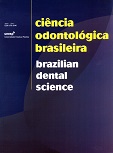Análise morfológica e morfométrica do tecido subcutâneo de ratos submetidos à ação de pasta de hidróxido de cálcio e óleo de Ricinus communis
DOI:
https://doi.org/10.14295/bds.2008.v11i3.507Abstract
ResumoNeste presente estudo foram comparadas duas composições de pastas medicamentosas para utilização intracanal: pasta de hidróxido de cálcio e óleo de Ricinus communis e pasta de hidróxido de cálcio e polietilenoglicol. Tubos de polietileno foram implantados no tecido subcutâneo de 9 ratos, sendo 2escapulares e 2 pélvicos, totalizando 4 tubos por animal, cada par com uma das pastas. O grupo controle foi definido pela lateral do tubo. Após 7, 21 e 42 dias os animais foram sacrificados e os tecidos processados para obtenção dos cortes histológicos e posterior análise histopatológica. Os resultados foram classificados quanto à severidade da reação inflamatória e quantificados em relação aos eventos presentes nas áreas pré-determinadas. Observou-se à análise morfológica, que ambas as pastas apresentaram índice de inflamação intenso aos 7 dias - pasta A (29,7) e pasta B (39,3), persistindo até aos 21 dias (pasta A – 27,1; pasta B – 27,9). Aos 42 dias a reação tecidual foi moderada (pasta A – 12,4; pasta B – 13,0). Comparando-se ao grupo controle, percebeu-se que este apresentava reação tecidual indo do moderado (14,2 aos 7 dias e 10,0 aos 21 dias) ao discreto (7,8 aos 42 dias). Quando submetidos à análise estatística (ANOVA – Tukey – p< .01) esses valores apresentaram diferença estatisticamente significante para todas as pastas e grupo controle. Concluiu-se que ambas as pastas apresentaram-se como irritantes ao tecido conjuntivo, permitindo colagenização progressiva da cápsula junto à abertura tubular. Porém, a pasta com óleo de Ricinus communis (Pasta A) apresentou potencial irritativo estatisticamente menor que a Pasta B.
Downloads
Downloads
Published
How to Cite
Issue
Section
License
Brazilian Dental Science uses the Creative Commons (CC-BY 4.0) license, thus preserving the integrity of articles in an open access environment. The journal allows the author to retain publishing rights without restrictions.
=================




























